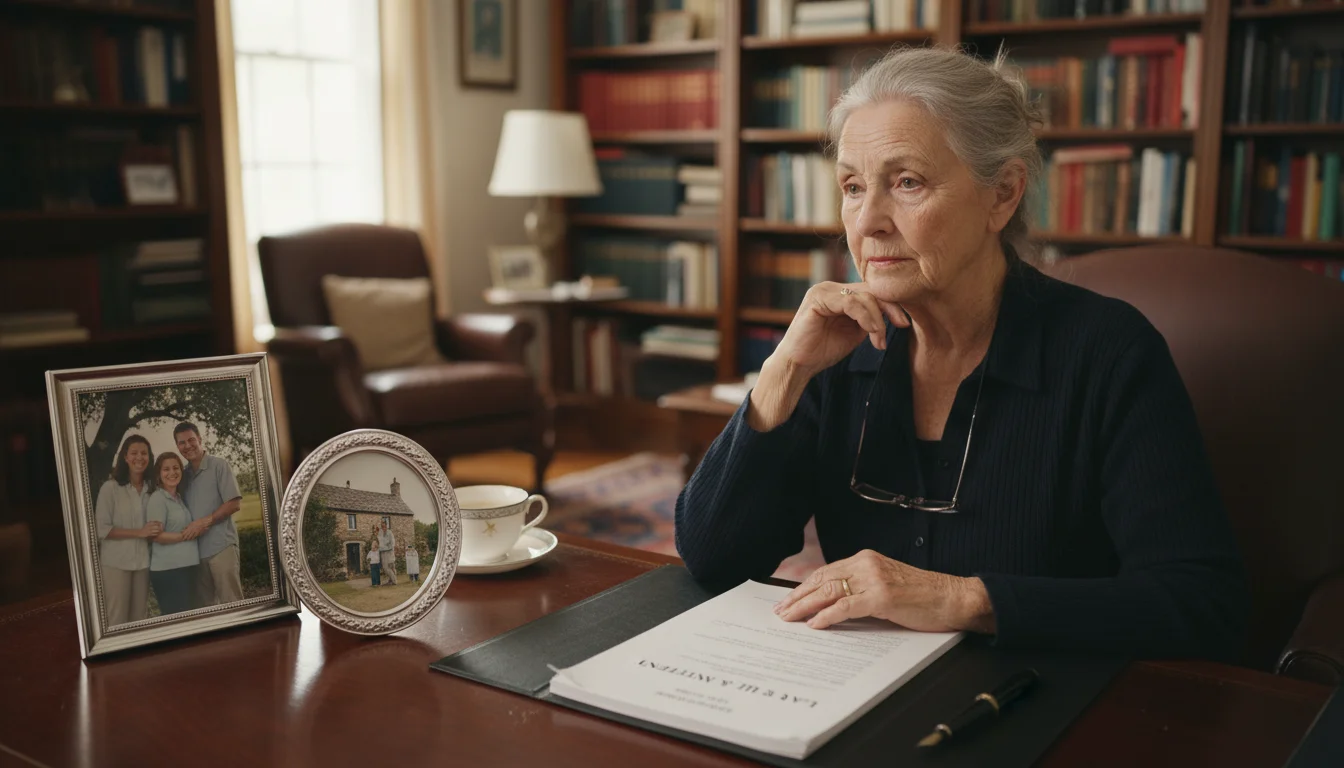

Introduction: Taking Control of Your Finances in Retirement
Blended families, born from remarriage later in life, are a source of great joy. They bring new relationships and expand our sense of family. However, this wonderful “yours, mine, and ours” dynamic also introduces significant complexity into one of the most important aspects of senior financial planning: your estate plan. When you have children from a previous marriage, a new spouse, and perhaps stepchildren you love as your own, a simple will is often not enough to ensure your wishes are carried out.
Without a carefully constructed plan, you risk leaving a legacy of confusion, conflict, and heartache. State laws, known as intestacy laws, will step in to decide who inherits your assets, and their rigid formulas rarely match the unique intentions of a blended family. This can lead to devastating and unintended outcomes, such as your surviving spouse receiving far less than you intended, or your own children being accidentally disinherited. The goal of estate planning is to replace uncertainty with clarity. By taking control now, you can create a legally sound strategy that protects your spouse, provides for all the children you wish to include, and secures your financial legacy, giving you and your loved ones true peace of mind.
HelpfulResourcesforSeniors.com: We provide trustworthy financial strategies and warnings to help you secure your future.

Understanding the Financial Basics of Estate Planning for Blended Families
Navigating estate planning can feel like learning a new language. But understanding a few key terms is the first step toward empowerment. These concepts are the building blocks of a secure plan, especially when it comes to the unique challenges of a blended family.

Key Terms You Need to Know
Estate: This is simply everything you own at the time of your death. It includes your home and any other real estate, bank accounts, investment and retirement funds, cars, life insurance policies, and personal belongings like jewelry or art.
Will: A Last Will and Testament is a legal document that outlines your instructions for how your property should be distributed. It also names an executor, the person or institution you trust to manage your estate and carry out those instructions. A will is a fundamental part of any plan, but for blended families, it has a major limitation: it must go through a court process called probate, which can be time-consuming, expensive, and public.
Trust: Think of a trust as a private contract you create to manage your assets. You transfer your assets into the trust, and a person you name (the trustee) manages them for the benefit of others (the beneficiaries). The most common type for estate planning is a Revocable Living Trust. It’s “revocable” because you can change or cancel it at any time while you are alive. The major advantage is that assets held in a trust bypass probate entirely, allowing for a faster, private, and more controlled distribution. This control is critical for blended families.
Beneficiary Designations: This is one of the most overlooked but powerful elements of estate law. For certain accounts, like your 401(k), IRA, annuities, and life insurance policies, you name a beneficiary directly on the account paperwork. This designation overrides whatever your will says. If your will leaves everything to your current spouse, but your ex-spouse is still listed as the beneficiary on your old life insurance policy, your ex-spouse will get the money. It’s a simple mistake with profound consequences.
Intestacy: This is the legal term for dying without a valid will. When this happens, your state’s laws of intestacy determine who inherits your property. These laws are inflexible. For example, in some states, if you have a spouse and children from a prior marriage, your estate might be split, with your spouse receiving one-half or one-third and your children receiving the rest. This could force the sale of the family home to pay your children their share, leaving your surviving spouse in a difficult position—an outcome almost no one would want.
Power of Attorney and Healthcare Directive: These are not for after you die, but are crucial for protecting you while you’re alive. A Durable Power of Attorney for finances names someone to manage your money if you become incapacitated. A Healthcare Directive (or Living Will) outlines your wishes for medical care and names a healthcare proxy to make decisions for you. In a blended family, it is vital to formally name who you want in these roles to prevent potential conflicts between your spouse and your children.
HelpfulResourcesforSeniors.com: We provide trustworthy financial strategies and warnings to help you secure your future.

Actionable Strategies and Money-Saving Tips
Creating an estate plan for a blended family is not about using a one-size-fits-all template. It’s about using the right legal tools to achieve your specific goals. Here are practical strategies to build a plan that protects everyone you love and avoids common inheritance tips pitfalls.

Strategy 1: Communicate Openly with Your Spouse
The most important step is often the most personal. Sit down with your spouse and have a frank and honest conversation. What are your goals? Do you want to ensure the surviving spouse can live comfortably for the rest of their life? How do you want to provide for your children versus your stepchildren? What about heirlooms or property owned before the marriage? Getting on the same page and understanding each other’s desires and obligations is the foundation for a successful plan and prevents disputes down the road.

Strategy 2: Use Trusts for Control and Protection
For blended families, trusts are often superior to wills because they provide far more control. They allow you to rule from the grave, in a good way, by ensuring your assets are used exactly as you intend.
A very powerful tool is the Qualified Terminable Interest Property (QTIP) Trust. It sounds complicated, but the concept is brilliant for blended families. Here’s how it works: You fund the trust with your assets. When you pass away, your surviving spouse receives all the income generated by the trust for the rest of their life. They are cared for and can maintain their lifestyle. But when your surviving spouse passes away, the remaining trust assets go to the beneficiaries you originally named—your children from your first marriage. This solves a primary dilemma: it provides for your spouse’s security while guaranteeing your children’s inheritance.
Example: John has $1 million in investments and two adult children. He marries Carol, who has her own children. John places his $1 million into a QTIP trust. When he dies, Carol receives the investment income (let’s say $40,000 per year) for life. She is financially secure. When Carol dies, the original $1 million principal in the trust is distributed to John’s two children, just as he wished.

Strategy 3: Review and Update Every Beneficiary Designation
This is not optional; it is mandatory. After a remarriage, you must review every single account that has a named beneficiary. This includes your IRAs, 401(k)s, life insurance policies, and annuities. Make a list, check the current beneficiary for each, and update them to reflect your current wishes. This simple housekeeping task can prevent your entire life savings from accidentally going to an ex-spouse.
You can also use these designations strategically. For instance, you might make your spouse the sole beneficiary of your substantial 401(k) to ensure their retirement security, while naming your children as the equal beneficiaries of a large life insurance policy to provide their inheritance. This can be a clean and effective way to divide assets without forcing the sale of property.

Strategy 4: Pay Attention to How Assets Are Titled
The way you own property with your spouse has massive implications for inheritance. The most common form of ownership for married couples is Joint Tenancy with Right of Survivorship (JTWROS). This means when one owner dies, the other automatically inherits the entire asset, regardless of what a will says. While convenient, it can disinherit your children. If your family home is titled as JTWROS with your new spouse, they will own it 100% upon your death. They are then free to leave it to their own children, cutting yours out completely.
An alternative for certain assets is Tenants in Common (TIC). With TIC, each owner has a distinct, separate share. You can own 50% and your spouse can own 50%. Your will controls what happens to your share. You could leave your 50% interest in a vacation cabin to your children, ensuring they inherit part of it.

Strategy 5: Create a Personal Property Memorandum
Often, the most bitter family disputes are not over money, but over sentimental items: your mother’s wedding ring, a grandfather clock, a set of tools. These items may have little monetary value but immense emotional significance. You can prevent these conflicts by creating a personal property memorandum. This is a simple document, referenced in your will, that lists specific personal items and who you want to receive them. It is legally binding in most states and can be a powerful tool for preserving family harmony.
HelpfulResourcesforSeniors.com: We provide trustworthy financial strategies and warnings to help you secure your future.

Financial Red Flags and Scams to Watch Out For
In addition to creating a solid plan, a key part of senior financial planning is knowing what to avoid. In the context of blended families, certain mistakes and bad advice can be particularly destructive.

Red Flag 1: The “Sweetheart Will” Mistake
This is perhaps the most common and devastating pitfall. A “sweetheart will” is where you and your spouse create simple wills leaving everything to each other. You have a verbal agreement that whichever of you survives will then divide the remaining combined estate fairly among all the children from both sides. It sounds simple and trusting. It is a terrible idea.
The surviving spouse has no legal obligation to honor that verbal promise. After you’re gone, life happens. The survivor could remarry, have health issues that drain the estate, or be influenced by their own children to write a new will that excludes your kids entirely. Once you pass away and they inherit the assets, they have complete control. The only way to guarantee your children receive their inheritance is to build that guarantee into a legal structure like a trust.

Red Flag 2: Overlooking the Impact of an Old Prenup
If you or your spouse had a prenuptial agreement from a previous marriage, it could have lingering effects. More importantly, if you have significant separate assets coming into your current marriage, a postnuptial agreement can be a wise decision. It’s a contract signed after marriage that clarifies how assets would be divided in case of divorce or death. It can preemptively waive certain spousal inheritance rights defined by state law, giving you more freedom to direct your separate property to your own children through your estate plan.

Red Flag 3: The “One-Size-Fits-All” Advisor
Be cautious of any advisor who immediately pushes a complex and expensive product without first deeply understanding your family dynamics and goals. Some advisors, motivated by high commissions, might recommend unnecessary irrevocable trusts or complex annuities that limit your flexibility. A good advisor or attorney will listen first. They will ask detailed questions about your assets, your spouse, your children, and your stepchildren. Your plan should be customized to you. If you feel pressured or confused, that’s a major red flag. Always seek advice from an experienced estate planning attorney or a fee-only Certified Financial Planner (CFP) who specializes in these matters. For consumer protection, you can consult resources from the Consumer Financial Protection Bureau (CFPB) and the FTC.
HelpfulResourcesforSeniors.com: We provide trustworthy financial strategies and warnings to help you secure your future.

A Financial Checklist for Estate Planning for Blended Families
Taking action can feel overwhelming, so here is a simple checklist to guide you through the process. Think of it as your roadmap to creating a secure and effective estate plan.
First, begin by gathering all your important financial documents. This includes deeds to real estate, statements for bank and investment accounts, retirement account summaries, life insurance policies, and any existing wills or trust documents. Having everything in one place will make the process much smoother.
Second, as we’ve discussed, sit down with your spouse for an open conversation. Create a written list of your assets and, more importantly, a list of your shared and individual goals. Who do you need to provide for, and how do you envision doing it? Be specific about your intentions for your spouse, your children, and your stepchildren.
Third, use this information to find and consult with a qualified estate planning attorney. Do not try to do this yourself with online forms. Your situation is complex. Specifically look for an attorney who has experience with estate law and blended families. They will be familiar with tools like QTIP trusts and can provide the best guidance.
Fourth, once you are working with your attorney, a critical task is to meticulously review and update the beneficiary designations on every retirement account and life insurance policy you own. Ensure they align perfectly with the new estate plan you are creating.
Finally, after your new will, trust, and other documents are drafted and signed, you must “fund” your trust by retitling your key assets (like your home and brokerage accounts) in the name of the trust. Your attorney will guide you on this. Once complete, store the original documents in a safe, accessible place, such as a fireproof safe or a safe deposit box, and make sure your named executor and trustee know where to find them.
HelpfulResourcesforSeniors.com: We provide trustworthy financial strategies and warnings to help you secure your future.

Frequently Asked Questions
1. Can I treat all my children—biological and stepchildren—equally in my will?
Yes, absolutely. The law allows you to leave your assets to whomever you choose. The key is to be extremely clear and specific in your legal documents. To avoid ambiguity, name each individual child and stepchild you wish to inherit by their full name. Do not use vague collective terms like “my children” or “my issue,” as these can be legally challenged and may be interpreted by a court to mean only your biological or legally adopted children.
2. What happens to my Social Security benefits when I die? Can my new spouse claim them?
Your Social Security benefits are a crucial part of your senior financial planning. When you pass away, your surviving spouse may be eligible for survivor benefits based on your work record. Generally, they can claim a survivor benefit if they are at least 60 years old (or 50 if disabled) and it is higher than their own retirement benefit. Remarrying can affect eligibility, so it’s a complex area. For official rules and to understand your specific situation, it’s best to consult the source. For official information on Social Security and Medicare, visit SSA.gov and Medicare.gov. Federal tax information is at the IRS.
3. My new spouse moved into the home I owned before we were married. How do I ensure they can live there after I’m gone, but that the house eventually goes to my kids?
This is a classic blended family scenario and a perfect use case for a trust. You can include a provision in your revocable living trust that creates a “life estate” for your spouse in the home. This gives your spouse the legal right to live in the house for the remainder of their life. The trust can also specify who is responsible for paying for upkeep, property taxes, and insurance. Upon your spouse’s death, the life estate terminates, and the ownership of the house transfers automatically to your children, as named in the trust. This protects your spouse’s housing and your children’s inheritance.
4. We have a simple will. Isn’t that enough for our blended family?
For most blended families, a simple will is not enough. It leaves too much to chance. As discussed, it does not solve the “Sweetheart Will” problem where a surviving spouse can unintentionally or intentionally disinherit your children. Furthermore, a will guarantees your estate will go through the public, often slow, and sometimes costly probate process. A well-drafted trust provides much more privacy, asset protection, and specific control to ensure your exact wishes are followed without court intervention.
5. How much does it cost to set up a proper estate plan?
The cost varies significantly based on your location and the complexity of your estate. A simple will might be prepared by an attorney for a few hundred dollars. A more comprehensive plan involving a revocable living trust and other documents will likely cost several thousand dollars. While this may seem like a significant expense, it’s crucial to view it as an investment. The cost of not having a proper plan—measured in potential legal fees, family strife, and lost inheritance for your loved ones—is almost always far, far greater.
Disclaimer: This article is for informational purposes and is not a substitute for professional financial or tax advice. Consult with a certified financial planner or tax professional for guidance on your specific situation.
For expert guidance on senior health and finance, visit AARP, Alzheimer’s Association, American Heart Association and Benefits.gov.
|
Fact-Checked Content
Our editorial team reviews all content for accuracy and updates it regularly. Learn about our editorial process →
|


















